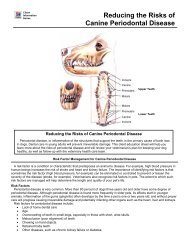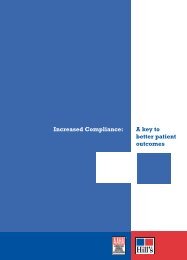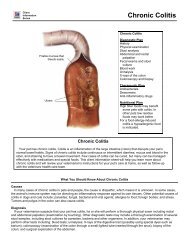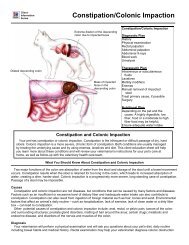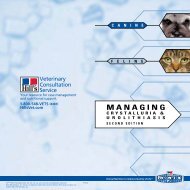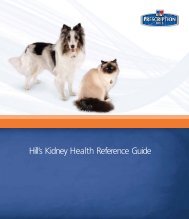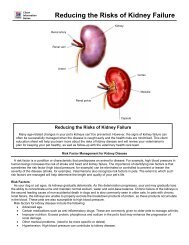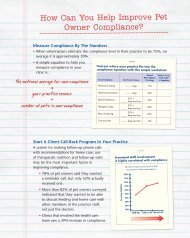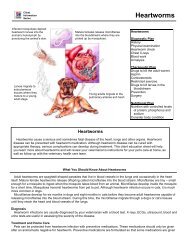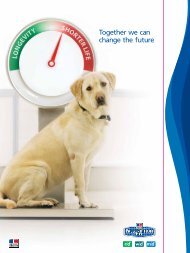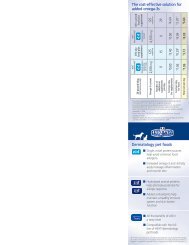Giardia - HillsVet
Giardia - HillsVet
Giardia - HillsVet
Create successful ePaper yourself
Turn your PDF publications into a flip-book with our unique Google optimized e-Paper software.
Client<br />
Information<br />
Series<br />
<strong>Giardia</strong><br />
<strong>Giardia</strong><br />
<strong>Giardia</strong><br />
species exist<br />
as motile<br />
trophozoites<br />
and nonmotile<br />
cysts. Both<br />
forms are<br />
transmitted by<br />
ingestion and<br />
are passed<br />
intermittently<br />
in the host’s<br />
feces.<br />
Diagnostic Plan<br />
History<br />
Physical examination<br />
Stool analysis<br />
Analysis of intestinal<br />
scrapings collected during<br />
endoscopy<br />
Therapeutic Plan<br />
Drugs to kill the parasite<br />
Nutritional Plan<br />
Nutrition based on individual<br />
patient evaluation<br />
including body condition<br />
and other organ system<br />
involvement or disease<br />
<strong>Giardia</strong><br />
Your pet has <strong>Giardia</strong>. <strong>Giardia</strong> are microscopic parasites that live in the small intestines of dogs and cats.<br />
<strong>Giardia</strong>sis, the disease caused by <strong>Giardia</strong>, is characterized by weight loss and chronic diarrhea. <strong>Giardia</strong>sis is<br />
treated with drugs that rid the body of the parasite and with medications to treat diarrhea. This client education<br />
sheet will help you learn more about <strong>Giardia</strong> infection and will review your veterinarian’s instructions for your<br />
pet’s care at home, as well as follow-up with the veterinary health care team.<br />
What You Should Know About <strong>Giardia</strong><br />
<strong>Giardia</strong> (je-ar' de-ah) exist in two forms: teardrop-shaped trophozoites and oval cysts. Both forms are invisible to the eye,<br />
but can be seen with the aid of a microscope. Infection occurs when a dog or cat ingests the cyst stage of the parasite.<br />
Noninfected animals usually acquire the infection when they come in contact with infected animals, cyst-laden feces or<br />
contaminated food and water. Likely places of infection include kennels and vacation sites, especially in mountainous<br />
areas. <strong>Giardia</strong> cysts may survive for weeks in cold, wet climates.<br />
Once in the small intestine, the cyst matures into the trophozoite form, which attaches to the lining of the digestive tract.<br />
Five to 10 days after infection, trophozoites and cysts appear in the stool of the newly infected animal. These cysts serve<br />
as a source of infection for other animals. Younger dogs and cats (less than 3 years old) are most susceptible, especially<br />
animals less than 12 months of age.<br />
There is a slight chance that people may be susceptible to <strong>Giardia</strong> infections acquired from pets. Therefore, all animals<br />
with giardiasis should be treated to reduce the chance for human exposure.<br />
Diagnosis<br />
Microscopic examination of fresh stool specimens by your veterinarian is the usual method of finding <strong>Giardia</strong>. However,<br />
cysts and trophozoites may only appear sporadically in the stool. Therefore, several microscopic examinations of feces
over several days may be required to establish a diagnosis. These contents are then examined under a microscope.<br />
Some veterinary laboratories are capable of diagnosing <strong>Giardia</strong> infections through the use of special tests.<br />
Treatment and Home Care<br />
Several drugs exist for killing <strong>Giardia</strong> in your pet’s digestive tract. Animals with severe diarrhea may require antidiarrheal<br />
medications as well.<br />
Control measures should also be used to prevent reinfection and lessen the chances for human infection. Stools should<br />
be removed from kennels, yards and litter pans daily. Drying will destroy <strong>Giardia</strong> cysts, so litter pans and kennels should<br />
be kept as dry as possible. Disinfectants such as dilute chlorine bleach effectively reduce <strong>Giardia</strong> cyst contamination in<br />
areas where disinfectants can be used.<br />
Nutritional Plan<br />
If your pet has giardiasis, your veterinarian may suggest a dietary change based on your pet’s age and body condition,<br />
the degree of diarrhea and weight loss and the presence or absence of disease in other organs and body systems. If your<br />
pet has a severe infection, your veterinarian may give you special feeding instructions.<br />
Optimal nutrition should provide for a pet’s needs during each stage of its life. Optimal nutrition should also reduce the<br />
health risks associated with feeding excess levels of nutrients such as sodium, calcium, phosphorus, protein and fat.<br />
Foods that avoid these harmful excesses and provide proper nutrition for each life stage include Hill’s® Science Diet®<br />
brand pet foods.<br />
Transitioning Food<br />
Unless recommended otherwise by your veterinarian, gradually introduce any new food over a seven-day period. Mix<br />
the new food with your pet’s former food, gradually increasing its proportion until only the new food is fed.<br />
If your pet is one of the few that doesn’t readily accept a new food, try warming the canned food to body temperature,<br />
hand feeding for the first few days, or mixing the dry food with warm water (wait ten minutes before serving). Feed only<br />
the recommended food. Be patient but firm with your pet. This is important because the success or failure of treatment<br />
depends to a large degree on strict adherence to the new food.<br />
Presented as an educational service by<br />
Client’s Name:<br />
Patient’s Name:<br />
Medication(s):<br />
Home Care Instructions<br />
_________________________________________________________<br />
_________________________________________________________<br />
_________________________________________________________<br />
Nutritional Recommendation: ___________________________________________________<br />
Follow-Up Appointment: _______________________________________________________<br />
(Hospital Stamp Area Above)<br />
REGULAR VISITS WILL HELP OUR VETERINARY HEALTH CARE TEAM PROVIDE FOR YOUR PET’S BEST INTEREST.<br />
©2011 Hill’s Pet Nutrition, Inc.<br />
®/ Trademarks owned by Hill’s Pet Nutrition, Inc.



